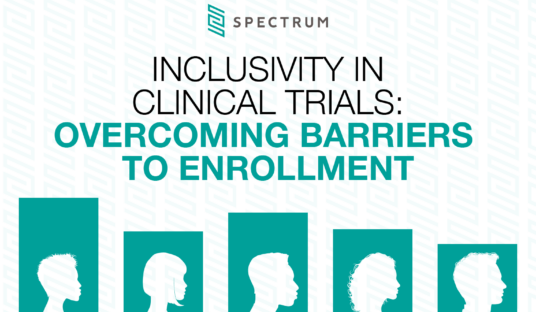Clinical Trial Experience
Clinical Trial Recruitment: Building a system that works for patients

The 2023 SCOPE conference wrapped up in late February and brought together some of the top professionals in clinical trials to learn, share and partner to address some of the biggest challenges in our industry. This year’s conference highlighted the need to improve the patient experience across every facet of their clinical trial journey. In the patient recruitment space, we are all too familiar with this reality. Despite there being an abundance of patients interested in joining a clinical trial, more than 80% of clinical trials fail to enroll on time and close to 50% of sites miss their enrollment targets.
At Spectrum, we are flipping the script on this conversation. Instead of thinking about it from the industry perspective, bemoaning the fact that we can’t enroll enough trial participants, we’re examining the challenge from the patient perspective. According to a study by Research!America, 80% of Americans are aware of the existence of clinical trials, and close to 3 in 4 (72%) Americans are open to joining a clinical trial, yet only a small percentage of patients in the United States actually join a clinical trial each year.
What’s keeping interested patients from finding and enrolling in clinical trials? The answer to this question is multifaceted but let’s start at the beginning of the patient journey…
Step 1: Searching for a Trial
Patients start with seeking information about their condition and treatment options, mainly online through social media or digital platforms like search engines—but doing so can be a challenging task for potential participants. So, what is the patient experience when they search for trials online?
- Overwhelming: Patients searching for a trial may face an overwhelming number of websites with information about different trials, potentially slipping down a rabbit hole.
- Confusing: Each trial website is different. Without universal formatting, patients must scour the site for the content that is most relevant to them.
- Stressful: Patients are often redirected to third-party websites that look significantly different from the original site and contain fragmented information, creating concern about where they have been redirected to.
Step 2: Learning More About a Trial
Once patients find a trial that may be a fit, they can submit their information in one of two ways: (1) sharing basic contact information (name, email, etc.); or (2) providing personal information (date of birth, gender, diagnosis, symptoms, etc.) to determine trial eligibility via a prescereening questionnaire.
Unfortunately, over 90% of patients who start a prescreener likely won’t enroll in the trial they find. Why?
- Discomfort: Patients may be unsure who they are sharing their information with, how it will be used, or what the follow-up will be. At this point, patients may decide to leave that particular prescreener or end their search entirely.
- Uncertainty: If patients complete the prescreener, they must decide if they should continue searching for other trials or wait to see what happens with the information they just submitted.
- Frustration: After completion, many will learn they are ineligible for that particular trial. For those patients who submit only contact information, they then must wait, sometimes days or weeks, to be contacted—if they are ever contacted at all due to investigative sites’ bandwidth limitations and competing priorities.
The process of scouring websites and filling out forms involves such a significant investment of time and energy that even the most motivated patients may give up in despair.
Step 3: Qualifying for a Trial
If patients succeed in finding a trial, each have specific eligibility requirements, typically including a list of about 30 or so inclusion and exclusion criteria. Inclusion criteria include factors such as what stage of the disease a patient must be in, what symptoms the patient must be exhibiting, and what demographic criteria are desired (gender, age, etc.), among others. Exclusion criteria eliminate people who, for example, are smokers, are taking certain medications, or have other comorbidities. With this, patients often discover that they are not eligible for a particular study after all. At this stage in their journey, patients may experience disappointment and a sense of hopelessness—giving up on the idea of ever joining a clinical trial.
Compounding Factors
The process described above is that of a typical patient without any compounding factors. Now, consider the additional challenges for patients:
- A person with low-income levels who may not have easy access to technology and/or who is so busy working and caring for family that they don’t have time to search or attend trials
- A person of color who may already hold some doubts about the medical industry
- A person with a disease, like depression or Alzheimer’s, which impacts their ability to search for trials, or is dependent on loved ones to help with their search
Shifting Our Perspective
When we start with curiosity and compassion for the patient’s experience, we begin to understand why it is so hard for interested patients to find and enroll in a clinical trial. Other industries, such as retail, housing and banking, have adapted the mantra that the “user experience matters,” yet the clinical trial space continues to develop siloed, trial-specific recruitment and enrollment processes that are set up to meet the short-term needs of the industry as opposed to looking out for the needs of the patient.
- Online retailers, such as Amazon, have transformed shopping for consumers. Consumers can search for an item in one place, never leaving the retailer’s website and seeing important information presented concisely and uniformly.
- Organizations like the Michael J. Fox Foundation or the national bone marrow transplant registry ask people to join their registry in advance so that, if they are ever a match and might be able to help, they can be contacted and connected to specific trials.
- Finance organizations have implemented digital solutions to provide convenient end-to-end customer solutions designed to facilitate online banking and financial services.
Spectrum’s Work
How can we build a system that works for the patients? Spectrum is an integrated marketing and communications agency that invests in building innovative, people-centered solutions to some of the most pressing healthcare challenges of our time. Within the global clinical trial patient recruitment space, we research, develop and tailor solutions to the experiences of patients and caregivers knowing that, when we focus on what is best for the patient, we enable the advancement of new treatments and technologies that benefit us all.
Spectrum starts with creating a deep connection to each patient population and understanding their unique experiences. Then, we work collaboratively with patient populations to shape everything from study design to recruitment and communication plans, and our communication and engagement tools designed for clinical trials. From this place of shared understanding, we invest in technology that increases the accessibility of trials, reduces barriers to patient engagement and creates a more positive and seamless experience for patients.
With our human-centered approach, our deep research and analytical capabilities and our innovative technological solutions, we are taking on the challenge of changing the face of clinical trial recruitment. We hope you’ll join us on our journey.
This article was orginally published on LinkedIn by Altair Silva, SVP, Clinical Trial Recruitment.
Perspectives

Clinical Trial Experience
Inclusivity in Clinical Trials: Overcoming Barriers to Enrollment

Clinical Trial Experience
FDA Additions to Informed Consent – Will they help improve participant engagement?

Clinical Trial Experience
The Power of Patients as Partners 2023 Conference: Turning Insights into Action

Clinical Trial Experience
Diversity in Clinical Trials: Beyond Fantasy





